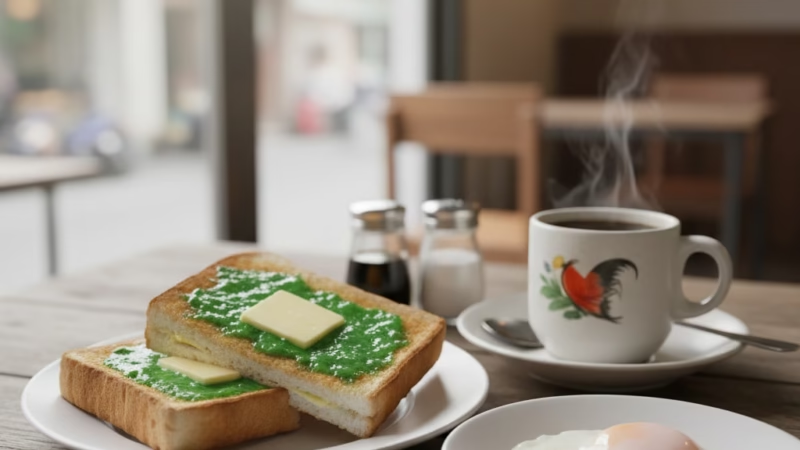Kaya Toast

Malaysia Food
Kaya Toast is a traditional breakfast or snack, cherished in Singapore and Malaysia.
Origin
Originating from Singapore with strong Peranakan influence, Kaya Toast quickly became a staple across Malaysia.
Category
Breakfast, snack, or tea-time food.
Appearance
Golden-brown toasted bread, layered with a green-hued kaya spread and a slab of butter, usually cut diagonally.
Ingredients
- Bread (white or wholemeal)
- Kaya (coconut milk, eggs, sugar, pandan leaves)
- Butter
Preparation
Bread is toasted or grilled until crisp, then generously layered with kaya and butter before serving.
Equipment
- Toaster or charcoal grill
- Knife or spatula
- Pan for traditional grilling (optional)
Variations
- Soft Kaya Toast (lightly toasted bread)
- Served with half-boiled eggs
- Modern twists: chocolate kaya, cheese kaya, multigrain bread
Taste
Sweet, creamy, rich, with subtle pandan fragrance.
Texture
Crispy on the outside, soft and smooth inside.
Aroma
Fragrant coconut and pandan with buttery notes.
Sound
Crunchy bite from toasted bread.
Cultural Significance
Kaya Toast is iconic in Singapore and Malaysia, symbolizing local heritage and communal breakfast culture.
Symbolism
Represents Peranakan culinary influence and traditional coffee shop (“kopitiam”) culture.
Regional Cuisine
Predominantly Singaporean and Malaysian, especially in Penang, Malacca, and Johor.
Social Context
Often enjoyed at kopitiams with coffee or tea, Kaya Toast is a beloved comfort food for locals.
Nutritional Information
- Calories: ~200–250 per serving
- Carbohydrates: moderate
- Fats: high
- Protein: low
Health Benefits
Provides quick energy, with medium-chain triglycerides (MCTs) from coconut milk.
Dietary Restrictions
Not suitable for vegans; high sugar content may not be suitable for diabetics.
Allergens
Eggs, dairy (butter), coconut.
Cost
Affordable; typically USD $1–$2 in local kopitiams.
Production
Kaya is made by slow-cooking coconut milk, eggs, sugar, and pandan until thick. Toast is prepared fresh daily.
Sustainability
Depends on sourcing of eggs, sugar, and coconut; often small-scale and locally produced.
Availability
Widely available in Singapore and Malaysia—from traditional kopitiams to modern cafes.
History
Kaya Toast originated in early 20th-century Singapore with Peranakan influence. Traditionally, bread was charcoal-grilled for a distinct flavor.
Anecdotes
- Often paired with local kopi (coffee) or teh tarik for authentic breakfast.
- Some kopitiams have been family-run for generations, preserving the traditional recipe.
How to Prepare
- Toast two slices of bread until golden brown.
- Spread kaya generously on one slice.
- Add a slab of butter.
- Top with the second slice.
- Serve with soft-boiled eggs and coffee for authenticity.
FAQ
Can I use store-bought kaya? Yes, but homemade kaya offers richer flavor.
Can it be made vegan? Substitute coconut-based butter and skip eggs in kaya.
Best coffee pairing? Local kopi or teh tarik complements the sweetness.
How long does kaya last? Usually 1–2 weeks refrigerated.





Comments are closed.